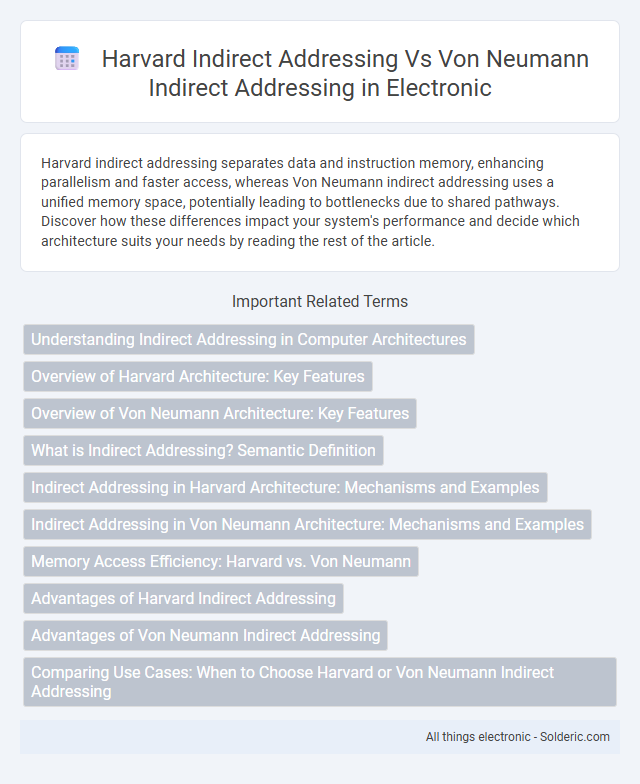Harvard indirect addressing separates data and instruction memory, enhancing parallelism and faster access, whereas Von Neumann indirect addressing uses a unified memory space, potentially leading to bottlenecks due to shared pathways. Discover how these differences impact your system's performance and decide which architecture suits your needs by reading the rest of the article.
Comparison Table
| Aspect | Harvard Indirect Addressing | Von Neumann Indirect Addressing |
|---|---|---|
| Memory Architecture | Separate memory for instructions and data | Unified memory for instructions and data |
| Addressing Mechanism | Indirect address points to data in separate data memory | Indirect address points to data in shared memory |
| Access Speed | Faster due to parallel instruction and data fetch | Slower due to shared bus and sequential access |
| Complexity | More complex hardware due to separate buses | Simpler hardware with a single memory bus |
| Use Case | High-performance systems needing speed | General-purpose computing with lower cost |
Understanding Indirect Addressing in Computer Architectures
Indirect addressing in Harvard architecture separates instruction and data memory, allowing the program counter to fetch instructions from a distinct memory space while using an indirect address register to reference data locations, which enhances parallelism and speeds up access. Von Neumann architecture utilizes a unified memory structure where indirect addressing involves the instruction fetching a memory address that points to the actual data, potentially causing bottlenecks due to instruction and data sharing the same memory path. Comparing both, Harvard's indirect addressing improves efficiency by minimizing instruction-data conflicts, while Von Neumann's approach offers simplicity in design but can suffer latency from memory access contention.
Overview of Harvard Architecture: Key Features
Harvard architecture features separate memory spaces for instructions and data, allowing simultaneous access and improved processing speed. Indirect addressing in this architecture accesses data or instructions via pointers stored in distinct memory locations, enhancing parallelism and efficiency. Your programs benefit from reduced memory access bottlenecks compared to Von Neumann systems, where instructions and data reside in a single shared memory.
Overview of Von Neumann Architecture: Key Features
Von Neumann architecture features a single memory space that stores both instructions and data, leading to a bottleneck known as the Von Neumann bottleneck. Indirect addressing in Von Neumann systems involves accessing memory locations where the address of the target operand is stored, enabling flexible memory referencing. Harvard architecture, in contrast, separates instruction and data memory, which improves access speed and avoids contention during indirect addressing operations.
What is Indirect Addressing? Semantic Definition
Indirect addressing in computing refers to a method where the address stored in a memory location points to the actual data location, enabling flexible data access. Harvard architecture separates memory for instructions and data, allowing indirect addressing to refer to different address spaces, enhancing efficiency in instruction execution. In contrast, Von Neumann architecture uses a unified memory for instructions and data, making indirect addressing involve a single memory space, which simplifies hardware design but may reduce processing speed.
Indirect Addressing in Harvard Architecture: Mechanisms and Examples
Harvard architecture uses separate memory spaces for instructions and data, allowing indirect addressing through dedicated data memory pointers, which reference memory locations indirectly without mixing instruction fetches. This mechanism enhances execution speed and security by isolating program code from data operations, exemplified in microcontrollers like the PIC series where pointer registers access data memory indirectly. Your programs benefit from predictable timing and reduced conflicts since indirect addressing leverages separate buses and memory systems unique to Harvard architecture.
Indirect Addressing in Von Neumann Architecture: Mechanisms and Examples
In Von Neumann architecture, indirect addressing uses a memory location specified in the instruction to hold the address of the actual data, enabling flexible data access and dynamic memory referencing. For example, an instruction might contain a pointer to a memory address, which then stores the effective address of the operand, facilitating operations like array processing and dynamic data structures. This mechanism contrasts with Harvard's separated memory paths by centralizing instructions and data in a single memory space, potentially affecting performance due to shared bus contention.
Memory Access Efficiency: Harvard vs. Von Neumann
Harvard architecture separates instruction and data memory, enabling simultaneous access and significantly improving memory access efficiency by reducing bottlenecks during indirect addressing. In contrast, Von Neumann architecture uses a single memory space for instructions and data, leading to potential delays as indirect addressing requires sequential memory accesses. Your system's performance in memory-intensive tasks can benefit from Harvard's parallelism, whereas Von Neumann's unified memory simplifies design but may hinder indirect addressing speed.
Advantages of Harvard Indirect Addressing
Harvard indirect addressing provides distinct memory separation for instructions and data, which enhances parallelism and increases processing speed in embedded systems and digital signal processors. This architecture reduces bottlenecks compared to Von Neumann indirect addressing, where a single memory space handles both code and data, potentially causing read/write conflicts. The clear partitioning in Harvard indirect addressing also improves security and reliability by isolating program instructions from data manipulation.
Advantages of Von Neumann Indirect Addressing
Von Neumann indirect addressing offers greater flexibility by allowing instructions and data to share the same memory space, which simplifies program design and enables dynamic memory access. This shared memory structure supports self-modifying code and easier implementation of recursive functions. The unified memory model reduces hardware complexity and cost, enhancing overall system efficiency compared to Harvard architecture's separated instruction and data memories.
Comparing Use Cases: When to Choose Harvard or Von Neumann Indirect Addressing
Harvard indirect addressing is ideal for applications requiring simultaneous access to instructions and data, such as digital signal processing or embedded systems, due to its separate memory pathways enhancing parallelism and speed. Von Neumann indirect addressing suits general-purpose computing where unified memory access simplifies programming and reduces hardware complexity, making it effective for tasks with dynamic data and instruction requirements. Your choice depends on prioritizing performance in specialized hardware (Harvard) versus flexibility and simplicity in conventional computing environments (Von Neumann).
Harvard indirect addressing vs Von Neumann indirect addressing Infographic

 solderic.com
solderic.com